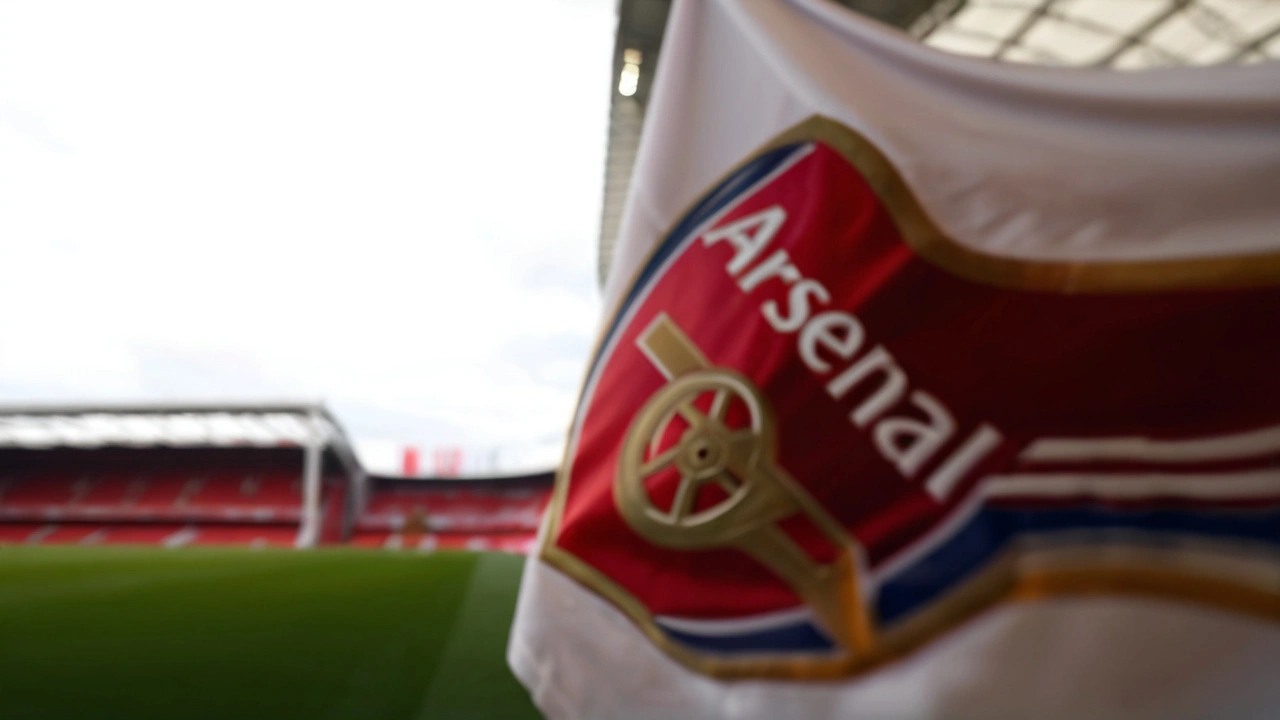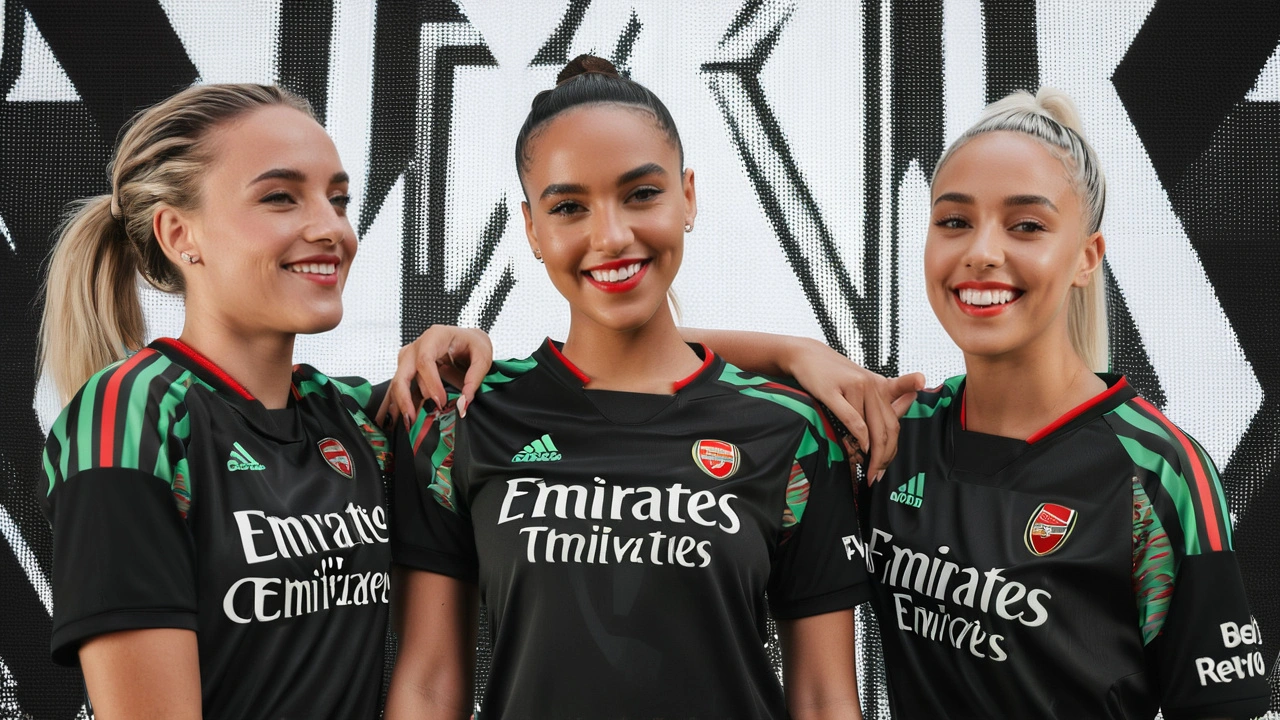Arsenal Unveils New 2024/25 Away Kit
The North London football giants, Arsenal, have revealed their latest away kit for the 2024/25 season. This kit is not just clothing for the players but a vibrant canvas celebrating the rich cultural contributions of the African diaspora. It stands as a testament to the club's ever-deepening connections with diverse cultural fabrics both within London and across continents.
The design itself is an eye-catcher. At its core, the kit boasts a sleek black base, which effortlessly balances modernity with tradition. However, its true piece de resistance is the intricate white zig-zag graphic. This bold design element meanders from under the player's arm, flows down the sides of the torso, and continues onto the shorts. This isn't just a decorative motif; it symbolizes the movement and flow of people, reminiscent of the journeys and migrations that have shaped the African diaspora over centuries.
This bespoke pattern wasn’t born out of a computer algorithm but was meticulously hand-drawn. Commonly found in African designs, artefacts, and decorations, this pattern embodies the heritage and artistic expressions that have flourished on the African continent. The integrity of this design is preserved thanks to the creative geniuses at Labrum London, a fashion label renowned for its unique blend of contemporary and traditional influences. Their partnership with Arsenal highlights a profound respect for cultural narratives, ensuring that each kit tells a story of identity and history.
Labrum London’s Creative Touch
Labrum London, spearheaded by creative director Foday Dumbuya, has made waves in the fashion industry with collections that harmonize modern silhouettes with cultural storytelling. Collaborating with Arsenal on this kit, Labrum has brought its deep understanding of cultural motifs and integrated them into a sportswear design that is both functional and visually captivating.
Speaking about the project, Dumbuya said, “We wanted to create something that wasn't just visually beautiful but also deeply meaningful. The zig-zag pattern is more than a design; it’s a visual narrative of the African diaspora's immense contributions and journeys, interpreted through the lens of sport and fashion.”
The result of this collaboration is a kit that transcends football. It is a melding of sport and culture, where every detail has been crafted to honor the stories and histories that often go untold. According to Arsenal's creative team, every aspect of the kit reflects a shared journey, a tribute to the influences that have shaped not only the club but also its fan base spanning the globe.
Modelling the New Kit
The club's top players have already been spotted sporting the new kit in a series of promotional photos. Football stars like Martin Odegaard, Beth Mead, William Saliba, Katie McCabe, Bukayo Saka, and Alessia Russo have brought the kit to life, embodying the ethos and ambition that the design represents. Each player's image in the promotional materials captures the spirit of unity and the celebration of cultural diversity that Arsenal aims to promote with this new design.
The photo series featuring these athletes not only showcases the aesthetic appeal of the kit but also emphasizes the club's commitment to representing its supporters from various backgrounds. It's a visual statement—Arsenal is more than a football club; it is a community that embraces and celebrates its multifaceted heritage.

Availability and Fan Reception
With the kit now available for purchase, the initial reception from fans suggests that it’s not just seen as sportswear. Many see it as a piece of culture and history, a tribute to the wider world that Arsenal represents. It’s an embodiment of the club’s identity and values, resonating deeply with supporters who are eager to wear their heritage with pride.
Long-time Arsenal fan Rachel Adeyemi shared her excitement, saying, “I’ve been an Arsenal supporter all my life, and this kit feels like it’s a part of me. It’s like wearing my history and my love for the club all at once.”
Feedback on social media has been overwhelmingly positive, with fans praising the club’s bold and inclusive design choices. Hashtags related to the new kit launch, such as #ArsenalAwayKit and #AfricanInspired, have been trending, highlighting the widespread enthusiasm and pride among the supporters.
This innovative and culturally rich approach to sportswear sets a new benchmark for football clubs worldwide, encouraging them to look beyond aesthetics and incorporate meaningful narratives into their designs. Arsenal’s 2024/25 away kit isn’t just for the players; it’s for everyone who finds a piece of their story in the zig-zag lines and the deep black fabric.
The Broader Implications for Sportswear Design
Arsenal’s commitment to celebrating cultural diversity through their 2024/25 away kit represents a significant step forward in sportswear design. It shows that apparel can be much more than just functional clothing—it can be a medium for storytelling, cultural expression, and social unity.
The new kit raises questions and possibilities for future designs. How will other clubs and brands respond? Will they adopt similar approaches, valuing cultural narratives as much as performance metrics? Only time will tell, but Arsenal has undoubtedly set a high standard.
Furthermore, this initiative opens a dialogue about the role of sports in broader societal contexts. Sport has always been a unifier, but with this new kit, Arsenal is pushing the boundaries, showing that sport can also be an educator and a preserver of cultural heritage. It’s a call to action for other institutions to recognize and celebrate the diverse histories and identities of their communities.
The Future of Cultural Expression in Sports
Looking ahead, this innovative move by Arsenal could pave the way for more collaborations between fashion designers and sports clubs. These partnerships have the potential to produce not only aesthetically pleasing designs but also deeply meaningful ones that resonate with fans on a personal level.
By bridging the gap between sport and culture, these collaborations can foster a deeper sense of community and belonging among supporters. For Arsenal, it’s a win-win situation—enhancing their brand identity while honoring the rich cultural tapestry that their global fan base represents.
As the 2024/25 season kicks off, Arsenal’s players will take to the pitch wearing more than just a football kit. They’ll be donning a symbol of unity, heritage, and pride—qualities that are as integral to the beautiful game as skill and strategy.
In conclusion, Arsenal's new away kit is more than just a uniform. It’s a vibrant celebration of culture, history, and community. As fans around the world eagerly buy the new kit, they are wearing a piece of a story that stretches across continents and generations—a story embodied in every stitch, line, and color of this remarkable design.


Nancy Perez de Lezama
The new away kit is both sleek and meaningful. The black base with the white zig‑zag pays tribute to the African diaspora in a respectful way.
Matt Heitz
From an ethical standpoint this collaboration sets a precedent that clubs must follow, lest they be accused of cultural appropriation with no substantive engagement. The deployment of indigenous motifs without proper acknowledgement would be intolerable, and Arsenal appears to have averted that pitfall by partnering directly with a designer of African descent. However, the broader football ecosystem must internalize this model to avoid tokenism. In professional sports, such initiatives should be measured against rigorous standards of authenticity and impact.
Susan Mark
It's cool to see a major club celebrate its diverse fan base. The design feels inclusive without being over‑the‑top, and the pattern looks genuinely hand‑drawn. If more teams adopt this kind of thoughtful approach, we’ll see a richer visual culture across the league.
Jason Jennings
Honestly, this feels like a marketing stunt more than a genuine tribute. While the aesthetics are decent, using a cultural symbol to sell jerseys cheapens its heritage. Clubs should focus on on‑field performance rather than flashy designs.
Diego Vargas
Ya know the kit's design is actually based on traditional tri‑patterns that have been used for generations across West Africa. It's not just a random zigzag; it's a symbolic representation of migrashuns and community ties. The collaboration with Labrum London shows that the club did their research, which is rare in the modern footy world.
Alex Lee
Looks like just a black shirt with a cheap pattern.
Vida Yamini
When you look at the new away kit you can see a deliberate effort to blend performance fabric with cultural storytelling the black foundation provides a neutral canvas that allows the white zig‑zag to really pop and catch the eye. The pattern itself is more than decorative it is a visual map of journeys across continents and through time. Each line can be read as a nod to the resilience and creativity of communities that have shaped both London and the broader football world. The collaboration with Labrum London brings a level of authenticity that many clubs lack because the designer comes from the very heritage being celebrated. This is not a superficial branding exercise but a partnership that respects the origins of the motifs. The kit also meets the technical demands of modern football it breathes well stays light on the players and holds up during intense matches. So the aesthetic does not compromise performance. Fans who wear the jersey will feel a sense of pride it connects personal identity with club allegiance and that kind of emotional resonance can enhance the matchday experience for supporters on the terraces and at home. The design invites conversation it educates people about the diaspora and the artistic traditions that inspire it. It stands as a template for how sport can act as a conduit for cultural education and inclusion. We should applaud Arsenal for taking this step and hope other clubs follow suit. The future of sportswear may well be defined by such thoughtful integrations. By wearing the kit supporters become ambassadors of a shared heritage. The visual language continues a long tradition of football clubs using symbols to tell stories. Ultimately the success of such designs will be measured by the lasting connection they forge between fans and the beautiful game.